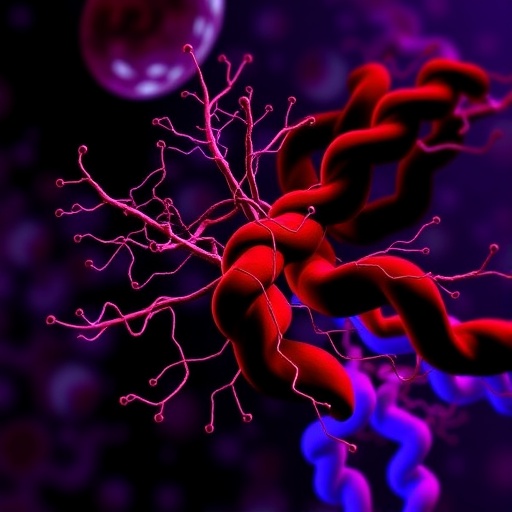In a groundbreaking study, researchers have unveiled the potential of 15,16-Dihydrotanshinone I as a formidable competitor in the ongoing battle against cancer. This remarkable compound has surfaced as a novel β-catenin-targeting inhibitor, showcasing its prowess in preventing the nuclear translocation of a key protein implicated in cancer progression. The implications of this discovery could reshape the way we understand and treat various cancers, providing hope for patients and transforming current therapeutic strategies.
β-Catenin, a pivotal player in the Wnt signaling pathway, is well-known for its role in the development and progression of numerous cancers. Its aberrant accumulation in the nucleus amplifies oncogenic signals, resulting in the activation of genes that foster tumor growth and metastasis. This study meticulously explores the molecular mechanisms by which 15,16-Dihydrotanshinone I intervenes in this process, providing a detailed analysis of its inhibitory effects on β-catenin’s translocation to the nucleus.
The research, spearheaded by a team from leading institutions, presents compelling evidence that this compound inhibits the expression of CD36, a scavenger receptor that has been tightly linked to tumor metabolism and growth. By reducing CD36 expression, 15,16-Dihydrotanshinone I disrupts the metabolic pathways that are often exploited by cancer cells to thrive and proliferate. This discovery could lead to a paradigm shift in cancer treatment, where targeting metabolic vulnerabilities becomes as crucial as inhibiting cell proliferation.
The synthesis of 15,16-Dihydrotanshinone I marks an important milestone in medicinal chemistry, showcasing innovative approaches to drug development. Its efficacy was assessed through a series of rigorous in vitro and in vivo experiments, demonstrating not only its ability to impede β-catenin nuclear translocation but also its impact on downstream signaling pathways pertinent to cancer cell survival. The results are not only promising but also reflect a meticulously crafted approach that emphasizes both efficacy and safety.
Cancer cells have been shown to adapt their metabolism to support aggressive growth, with altered lipid metabolism playing a significant role. CD36 is a critical receptor in this context, mediating fatty acid uptake and fostering lipid biosynthesis within tumors. The ability of 15,16-Dihydrotanshinone I to target this receptor could fundamentally change our approach to cancer therapy, focusing on the metabolic reprogramming of cancer cells rather than solely targeting their proliferative capacities.
Moreover, the potential applications of this groundbreaking compound extend beyond its current findings. Researchers are optimistic about its use in combination therapies, which have shown promise in enhancing the efficacy of existing treatments. By integrating 15,16-Dihydrotanshinone I into current therapeutic regimens, oncologists may improve patient outcomes significantly, especially for those with advanced or treatment-resistant cancers.
As this research continues to unfold, the implications for clinical application are profound. Researchers emphasize the potential for this compound to be developed into a therapeutic agent, potentially offering a new line of defense for patients facing some of the toughest challenges in oncology. Clinical trials, however, will be necessary to evaluate not only the efficacy of 15,16-Dihydrotanshinone I but also its long-term safety and tolerability in human patients.
The study’s multifaceted approach also sheds light on the biochemical pathways involved in cancer progression, highlighting how a deeper understanding of these processes can lead to more effective interventions. By elucidating the intricate relationship between β-catenin signaling and cellular metabolism, the researchers have opened new avenues for exploration in cancer biology.
In summary, the discovery of 15,16-Dihydrotanshinone I as a β-catenin-targeting inhibitor represents a significant advancement in cancer research. Its ability to inhibit nuclear translocation and reduce CD36 expression suggests a potent therapeutic option that merits further investigation. As we venture into an era of personalized medicine, the insights gained from this study will undoubtedly contribute to the development of targeted therapies that can effectively combat cancer with improved precision and outcomes.
This innovative study not only highlights the importance of targeting metabolic pathways in cancer treatment but also illustrates the continuous need for research and development in the field of oncology. The application of compounds like 15,16-Dihydrotanshinone I could usher in a new age of cancer therapeutics, bridging the gap between research and practical application to improve the prognosis for countless patients worldwide.
With ongoing studies and future clinical trials, the anticipation surrounding 15,16-Dihydrotanshinone I is palpable. The scientific community eagerly awaits further revelations about this promising compound and its potential role in reshaping cancer therapy, ultimately striving for a future where cancer may become a more manageable condition rather than a terminal diagnosis.
Subject of Research: Cancer treatment using 15,16-Dihydrotanshinone I as a β-catenin-targeting inhibitor.
Article Title: 15,16-Dihydrotanshinone I, a novel β-catenin-targeting inhibitor that inhibits its nuclear translocation and reduces downstream CD36 expression in cancer.
Article References:
Chen, M., Chen, B., He, Q. et al. 15,16-Dihydrotanshinone I, a novel β-catenin-targeting inhibitor that inhibits its nuclear translocation and reduces downstream CD36 expression in cancer.
J Transl Med 23, 1335 (2025). https://doi.org/10.1186/s12967-025-07317-1
Image Credits: AI Generated
DOI: https://doi.org/10.1186/s12967-025-07317-1
Keywords: 15,16-Dihydrotanshinone I, β-catenin, CD36, cancer therapy, nuclear translocation, metabolic pathways, oncogenesis.




